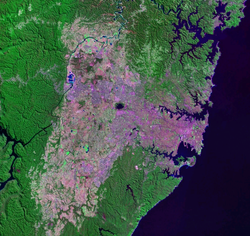
Back Llanura de Cumberland Spanish Plaine de Cumberland French Cumberland Plain ID Piana di Cumberland Italian Cumberland Plain NB کمبرلینڈ کا میدان Urdu
Cumberland Plain
Sydney Plain | |
|---|---|
 The Cumberland Plain covers the sweeping Greater Western Sydney area, from the Inner West to Penrith. | |
| Coordinates: 33°45′S 151°00′E / 33.750°S 151.000°E[1] | |
| Location | Greater Western Sydney, Northern Sydney, Inner West, St George |
| Area | |
| • Total | 2,750 km2 (1,060 sq mi) |
| Rivers | Hawkesbury River, Nepean River, Parramatta River, Georges River, Woronora River |
The Cumberland Plain, also known as Cumberland Basin,[2] is a relatively flat region lying to the west of Sydney CBD in New South Wales, Australia. An IBRA biogeographic region, Cumberland Basin is the preferred physiographic and geological term for the low-lying plain of the Permian-Triassic Sydney Basin found between Sydney and the Blue Mountains, and it is a structural sub-basin of the Sydney Basin.[3]
The Cumberland Plain has an area of roughly 2,750 square kilometres (1,060 sq mi), which lies on Triassic shales and sandstones. Shaping the geography of Sydney, it extends from 10 kilometres (6.2 mi) north of Windsor in the north, to Picton in the south; and from the Nepean-Hawkesbury River in the west almost to Sydney City, and includes parts of the Inner West and Northern Suburbs in the east. Much of the Sydney metropolitan area is located on the Plain. The Hornsby Plateau is located to the north and is dissected by steep valleys.[4]
The plain takes its name from Cumberland County, in which it is situated, one of the cadastral land divisions of New South Wales. The name Cumberland was conferred on the County by Governor Arthur Phillip in honour of Ernest Augustus, Duke of Cumberland.[1] Being the most populous region in Australia, the Cumberland Plain is one of the fastest-growing areas of the country in terms of population and it is home to a variety of Australian animal species, which are observable in the urban environments.[5]
- ^ a b "Cumberland". Geographical Names Register (GNR) of NSW. Geographical Names Board of New South Wales. Retrieved 4 August 2013.
- ^ "Age and origin of the Cumberland (Inner Sydney) Basin of southeast Australia". Taylor & Francis. 2020. Retrieved 5 December 2023.
- ^ Carter, Lewis (2011). Tectonic Control of Cenozoic Deposition in the Cumberland Basin, Penrith/Hawkesbury Region, New South Wales (Bachelor of Science (Honours) thesis). School of Earth & Environmental Sciences, University of Wollongong.
- ^ "Sydney Basin". Office of Environment & Heritage. 2014. Retrieved 12 July 2014.
- ^ Cooke, J.; Willis, T.; Groves, R. (2005). "Impacts of woody weeds on Cumberland Plain Woodland biodiversity". In Pellow, B.; Morris, C.; Bedward, M.; Hill, S.; Sanders, J.; Clark, J. (eds.). The ecology and management of Cumberland Plain habitats: a symposium. Campbelltown: University of Western Sydney. p. 7.